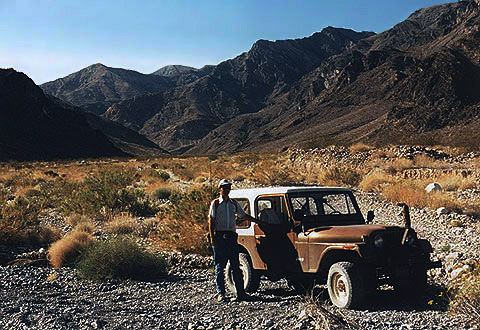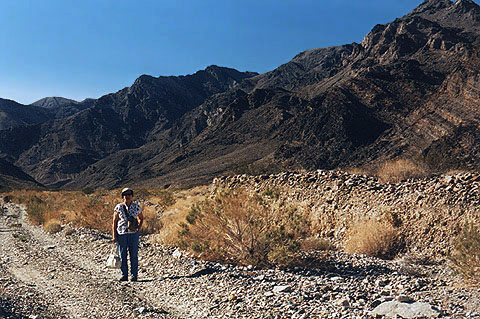


|
Two views of Trail Canyon, which takes off into the eastern side of the Panamint Range along the West Side Road, south of Death Valley Ranch. Here can be found one of the great Late Precambrian through Early Paleozoic geologic sections in all the Death Valley district--a generally conformable sequence of rocks exposed along the rather rough dirt trail. At the mouth of the canyon can be found a nice outcrop of the Upper Ordovician Ely Springs Dolomite--then, in decreasing order of geologic age, can be studied the Middle Ordovician Eureka Quartzite; the Lower to Middle Ordovician Pogonip Group (which contains large gastropods of the Paleseria variety, plus brachiopods and cystoid echinoderm debris); the Upper Cambrian Nopah Formation (produces trilobites and brachiopods); the Middle to Upper Cambrian Bonanza King Dolomite (locally abundant algal bodies called oncolites); the Lower to Middle Cambrian Carrara Formation (loads of trilobites, arthropod tracks and trails, and annelid trails); the Lower Cambrian Zabriskie Quartzite (vertical worm borings called Scolithus); the Upper Precambrian to Early Cambrian Wood Canyon Formation (trilobites, arthropod tracks and trails, annelid trails, brachiopod molds and echinoderm debris; and in 1997 Dr. Benjamin M. Waggoner and James W. Hagadorn described some interesting Ediacaran-type fossils from the lower member of the Wood Canyon and the underlying Stirling Quartzite, both Late Precambrian in age.); the Upper Precambrian Stirling Quartzite; the Upper Precambrian Johnnie Formation (check out Becky Charlton's page for a nice image of the Johnnie Formation and associated rock units in Trail Canyon); and the Upper Precambrian Noonday Dolomite (vast fossil algal mats called stromatolites have been reported from some of the carbonate beds). In the bottom photograph, the brownish Upper Cambrian Nopah Formation can be seen at the extreme right, while the dark gray Middle to Upper Cambrian Bonanza King Dolomite lies in the center of the picture. In the top image, the Nopah Formation again lies at the right (slightly brownish, bedded outcrops); at roughly the center is the Bonanza King Dolomite, and in the left distance occur older Cambrian geologic formations. |